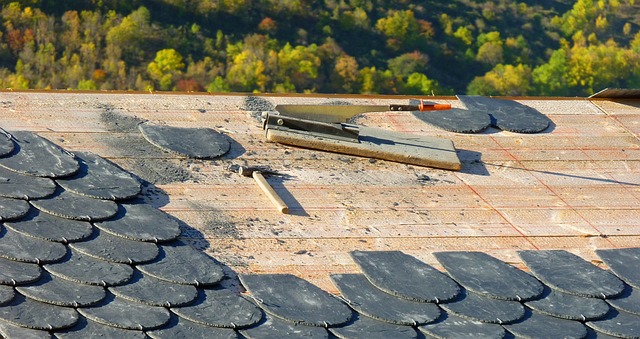When choosing a roofer for any residential or commercial project, it's crucial to select one who fully understands and complies with local building codes. These codes ensure public safety, health, and welfare by dictating materials, design, and structural integrity under environmental stressors like wind and snow loads. A knowledgeable roofer will integrate these standards throughout the roofing process, ensuring long-term structural integrity, smooth permit acquisition, and successful inspections. Non-compliance can lead to costly delays, rework, and legal complications. Thus, it's essential to hire a roofer well-versed in local building codes for a durable and compliant roofing solution that protects both the property owner's and the roofer's interests. Roofers must continuously stay informed about code updates and participate in ongoing education to maintain compliance, which is vital for both initial construction and future maintenance to prevent expensive corrections or legal issues. Their expertise ensures a secure and reliable built environment.
Navigating the complexities of local building codes and regulations is a critical aspect for any construction project, particularly in roofing. This article delves into the intricacies involved in ensuring compliance, emphasizing the role of skilled roofers in adhering to these standards. From understanding the significance of building codes to leveraging technology for compliance, each section offers valuable insights and practical steps to guarantee a compliant roofing project. Whether you’re a homeowner, a roofer, or an industry professional, this comprehensive guide will equip you with the knowledge necessary to navigate code requirements effectively, ensuring the safety, longevity, and success of your roofing endeavors.
- Understanding Local Building Codes and Their Importance
- The Role of a Roofing Contractor in Compliance
- Steps to Ensure Compliant Roofing Projects
Understanding Local Building Codes and Their Importance

When engaging a roofer for any residential or commercial roofing project, it is imperative to ensure that all work complies with local building codes and regulations. These codes are established by municipalities to safeguard public safety, health, and general welfare. They encompass a wide array of specifications regarding materials used, design standards, structural integrity, and even the orientation of the roof in relation to wind and snow loads. A knowledgeable roofer will be well-versed in these requirements and will apply them diligently to every aspect of the project. This adherence is crucial not only for the structural longevity of the building but also for obtaining the necessary permits and inspections that are legally mandated. Non-compliance can lead to significant delays, costly rework, and in some cases, legal consequences. Thus, it is in the best interest of both the property owner and the roofer to fully understand and adhere to these codes to ensure a successful project outcome that stands the test of time and regulatory scrutiny.
The Role of a Roofing Contractor in Compliance

When constructing or renovating a building, adherence to local building codes and regulations is paramount. A roofer plays a critical role in this process, ensuring that every aspect of the roofing system complies with the stipulated standards. The roofer’s expertise is essential in interpreting the complexities of these codes, which govern everything from the types of materials used to the slope and design of the roof structure. This compliance not only ensures the structural integrity and safety of the building but also its longevity and resistance to environmental stressors.
The roofer’s responsibilities extend beyond mere installation or repair; they are responsible for staying abreast of any updates or changes in local regulations. This dynamic nature of codes requires roofers to be vigilant and proactive, often engaging with building departments and attending continuing education courses to maintain their knowledge base. By doing so, they ensure that the work performed is not only up to current standards but also sets a foundation for future maintenance and repairs to comply with regulations as well. This proactive approach in compliance minimizes the risk of costly alterations or legal complications post-construction, ultimately providing peace of mind for both the property owner and the community at large.
Steps to Ensure Compliant Roofing Projects

Engaging a skilled roofer is paramount when undertaking roofing projects to ensure compliance with local building codes and regulations. Proficient roofers are well-versed in the current codes and standards, which dictate everything from materials used to the design and installation methods. Prior to any construction, the roofer should conduct a thorough review of the relevant code requirements specific to the geographic location and project type. This due diligence involves obtaining the necessary permits, understanding zoning laws, and verifying that all proposed work aligns with the prescribed safety and performance standards. The roofer must also remain apprised of any updates or changes to these codes, as they can evolve to incorporate new technologies or address safety concerns. Throughout the project, the roofer will ensure that each phase of construction adheres to these guidelines, from selecting compliant materials like fire-resistant shingles or solar roof integrations to executing the installation with proper techniques to prevent water intrusion or structural failures. By adhering to local building codes and regulations, the roofer not only safeguards the integrity of the roofing project but also ensures the safety and longevity of the structure it protects.
When engaging a roofer for any project, it is imperative to confirm their understanding and adherence to local building codes and regulations. These codes serve as safeguards for structural integrity, safety, and performance, ensuring that every installation or repair meets the necessary standards. By following the guidelines outlined in “Understanding Local Building Codes and Their Importance,” homeowners and contractors alike can appreciate the critical role these codes play in maintaining community order and quality of construction. The subsequent sections, “The Role of a Roofing Contractor in Compliance” and “Steps to Ensure Compliant Roofing Projects,” provide actionable advice for contractors to stay within legal boundaries while delivering top-notch services. In conclusion, due diligence in verifying compliance is essential for any roofing project, safeguarding both the property’s well-being and the homeowner’s interests.



